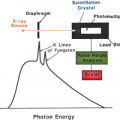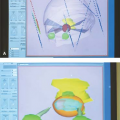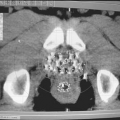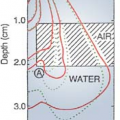Radiation Protection
Radiation exposure limits or standards were introduced as early as the start of the 20th century when the potential hazards of radiation were realized. One of the first standard-setting bodies was the International Commission on Radiological Protection (ICRP), which continues its function through its series of publications. These reports form the basis for many national protection guidelines. In the United States, the National Council on Radiation Protection and Measurements (NCRP) has functioned as a primary standard-setting body through its separate publications. One of the agencies with regulatory powers in this country is the Nuclear Regulatory Commission (NRC), which has control over the use of all reactor-produced materials (e.g., 60Co and 192Ir). The naturally occurring radioactive materials (e.g., radium and radon) and x-ray machines are regulated by individual states.
16.1. Dose Equivalent
Because the biologic effects of radiation depend not only on dose, but also on the type of radiation, the dosimetric quantity relevant to radiation protection is the dose equivalent (H). It is defined as:
where D is the absorbed dose and Q is the quality factor for the radiation.1
The SI unit for both dose and dose equivalent is joules per kilogram, but the special name for the SI unit of dose equivalent is sievert (Sv):
If dose is expressed in units of rad, the special unit for dose equivalent is called the rem:
Because Q is a factor and has no units:
The use of quality factor in radiation protection is analogous to the use of relative biologic effectiveness (RBE) in radiation biology. However, the quality factor is a somewhat arbitrarily chosen conservative value based on a range of RBEs related to the linear energy transfer (LET) of the radiation. Thus, the Q factor encompasses RBEs in a very broad sense, independent of the organ or tissue or of the biologic endpoint under consideration.
Although the dose equivalent for particular situations can be calculated (1), it is convenient for quick-and-rough calculations to have a table of practical quality factors available. Table 16.1 gives these approximate factors for a variety of radiations used in radiation therapy.
16.2. Effective Dose Equivalent
Whole body exposures are rarely uniform. For a given exposure received, internally or externally, dose equivalents for various tissues may differ markedly. Also, tissues vary in sensitivity to radiation-induced effects. To take into account these nonuniform irradiation situations, the concept of effective dose equivalent has been adopted by the ICRP and the NCRP. The effective dose equivalent
(HE), is defined as “the sum of the weighted dose equivalents for irradiated tissues or organs” (2). Mathematically:
(HE), is defined as “the sum of the weighted dose equivalents for irradiated tissues or organs” (2). Mathematically:
where WT is the weighting factor of tissue T and HT is the mean dose equivalent received by tissue T.
Table 16.1 Recommended Quality Factors | ||||||||||
|---|---|---|---|---|---|---|---|---|---|---|
| ||||||||||
The weighting factors represent the proportionate risk (stochastic) of tissue when the body is irradiated uniformly. They are derived from risk coefficients (i.e., risk per unit dose equivalent). Table 16.2 gives the weighting factors and the corresponding risk coefficients for various types of tissues and organs.
A. Risk Estimates
The risk estimates given in Table 16.2 include an assumption of full expression of the cancer risk and an assumption of a population distribution over all ages and both sexes. The genetic component includes severe genetic effects for the first two generations. In the total risk coefficient, the somatic risk is 125 × 10-4 Sv-1 (125 × 10-6 rem-1), which for radiation protection purposes is rounded off to 1 × 10-2 Sv-1 (1 × 10-4 rem-1). The genetic component of the risk is 40 × 10-4 Sv-1 (0.4 × 10-4 rem-1).
16.3. Background Radiation
Radiation is a part of the natural environment. This background radiation is contributed principally by three sources: terrestrial radiation, cosmic radiation, and radiation from radioactive elements in our bodies. Table 16.3 gives average values of background radiation to which various parts of the body are exposed annually. The total effective dose equivalent for a member of the population in the United States from various sources of natural background radiation is approximately 3.0 mSv/year (300 mrem/year).
Table 16.2 Recommended Values of the Weighting Factors WT, for Calculating Effective Dose Equivalent and the Risk Coefficients from which they were Derived | ||||||||||||||||||||||||||||||
|---|---|---|---|---|---|---|---|---|---|---|---|---|---|---|---|---|---|---|---|---|---|---|---|---|---|---|---|---|---|---|
| ||||||||||||||||||||||||||||||
Table 16.3 Estimated Total Effective Dose-Equivalent Rate for a Member of the Population in the United States and Canadaa from Various Sources of Natural Background Radiation | |||||||||||||||||||||||||||||||||||||||||||||||||||||||||||||||||||||
|---|---|---|---|---|---|---|---|---|---|---|---|---|---|---|---|---|---|---|---|---|---|---|---|---|---|---|---|---|---|---|---|---|---|---|---|---|---|---|---|---|---|---|---|---|---|---|---|---|---|---|---|---|---|---|---|---|---|---|---|---|---|---|---|---|---|---|---|---|---|
| |||||||||||||||||||||||||||||||||||||||||||||||||||||||||||||||||||||
The terrestrial radiation varies over the earth because of differences in the amount of naturally occurring elements in the earth’s surface. In addition, building materials may incorporate naturally occurring radioactive materials. Many buildings may have elevated levels of radon emitted by naturally occurring uranium-238 in the soil. It has been estimated (3) that the average annual dose equivalent to bronchial epithelium from radon decay products is approximately 24 mSv (2.4 rem).
Cosmic radiation levels change with elevation. For example, air travel exposes individuals to increased radiation exposure. It has been estimated that at 30,000 feet the dose equivalent is approximately 0.5 mrem/h (4).
The internal irradiation arises mainly from 40K in our body, which emits β and γ rays and decays with a half-life of 1.3 × 109 years.
In addition to the background radiation, the population is exposed to radiation from various medical procedures—the planned exposure of patients, as distinct from occupational exposures received by health personnel. It was estimated by the U.S. Public Health Service that the average annual genetically significant dose equivalent2 in 1970 was approximately 20 mrem/year from radiologic procedures.
Under ordinary circumstances, exposures from natural background radiation and medical procedures are not included in the occupational exposure controls for the individual cases.
16.4. Low-Level Radiation Effects
A vast literature exists on the biologic effects of radiation. Discussions pertinent to radiation protection can be found in reports of the United Nations Scientific Committee on the Effects of Atomic Radiation (6).
Whereas large doses of radiation produce identifiable effects within a relatively short period, the effects are difficult to ascertain at low doses (e.g., <10 cGy). The difficulty is due mainly to the extremely low frequency with which these effects might occur. The statistical problems are enormous in identifying small effects in the constant presence of spontaneously occurring effects. However, certain effects have been demonstrated in humans and other mammals at doses lower than those required to produce acute radiation syndrome but greatly in excess of dose limits recommended by the standards-setting bodies. Thus, exposures to low-level radiation may produce (a) genetic effects, such as radiation-induced gene mutations, chromosome breaks, and anomalies; (b) neoplastic diseases, such as increased incidence of leukemia, thyroid tumors, and skin lesions; (c) effect on growth and development, such as adverse effects on the fetus and young children; (d) effect on life span, such as diminishing of life span or premature aging; and (e) cataracts or opacification of the eye lens.
The harmful effects of radiation may be classified into two general categories: stochastic effects and nonstochastic effects. The NCRP (2) defines these effects as follows.
A stochastic effect is one in which “the probability of occurrence increases with increasing absorbed dose but the severity in affected individuals does not depend on the magnitude of the absorbed dose.” In other words, a stochastic effect is an all-or-none phenomenon, such as the development of a cancer or genetic effect. Although the probability of such effects occurring increases with dose, their severity does not.
A nonstochastic effect is one “which increases in severity with increasing absorbed dose in affected individuals, owing to damage to increasing number of cells and tissues.” Examples of nonstochastic effects are radiation-induced degenerative changes such as organ atrophy, fibrosis, lens opacification, blood changes, and decrease in sperm count.
Whereas no threshold dose can be predicted for stochastic effects, it is possible to set threshold limits on nonstochastic effects that are significant or seriously health impairing. However, for the purpose of radiation protection, a cautious assumption is made that “the dose-risk relationship is strictly proportional (linear) without threshold, throughout the range of dose equivalent and dose equivalent rates of importance in routine radiation protection.”
Many analysts believe that these two assumptions may overestimate the biologic effects at low dose levels. Some have proposed a linear quadratic dose-response curve that assigns relatively reduced effects to low doses. However, in the absence of more reliable data, it seems prudent to adopt a conservative model, the nonthreshold linear response, for predicting low-dose effects. For further discussion of dose-response models, the reader is referred to references 7 to 10.
16.5. Effective Dose-Equivalent Limits
NCRP (2) recommendations on exposure limits of radiation workers are based on the following criteria: (a) at low radiation levels the nonstochastic effects are essentially avoided; (b) the predicted risk for stochastic effects should not be greater than the average risk of accidental death among workers in “safe” industries; and (c) the ALARA principle should be followed, for which the risks are kept as low as reasonably achievable, taking into account social and economic factors.
It is important to compare radiation risks with the risks in other industries when setting radiation protection standards. Table 16.4 gives data on annual fatality rates from accidents in different occupations. On the basis of these data, “safe” industries are defined as “those having an associated annual fatality accident rate of 1 or less per 10,000 workers, that is, an average annual risk of 10-4 (2). The available data for the radiation industries show an average fatal accident rate of less than 0.3 × 10-4 (11). From this perspective, the radiation industries compare favorably with the “safe” industries. For radiation protection purposes, the total risk coefficient is assumed to be 1 × 10-2 Sv-1 (1 × 10-4 rem-1).
A. Occupational and Public Dose Limits
Table 16.5 gives occupational and public dose-equivalent limits as recommended by the NCRP (2). These limits do not include exposure received from medical procedures or the natural background. Radiation workers are limited to an annual effective dose equivalent of 50 mSv (5 rem) and the general public is not to exceed one tenth of this value (0.5 rem) for infrequent exposure
and 1 mSv (0.1 rem) for continuous or frequent exposure. Higher limits are set for some organs and areas of the body that involve nonstochastic effects and are less sensitive to radiation than others. For example, the annual occupational dose-equivalent limit to the lens of the eye is 150 mSv (15 rem) and to other organs is 500 mSv (50 rem).
and 1 mSv (0.1 rem) for continuous or frequent exposure. Higher limits are set for some organs and areas of the body that involve nonstochastic effects and are less sensitive to radiation than others. For example, the annual occupational dose-equivalent limit to the lens of the eye is 150 mSv (15 rem) and to other organs is 500 mSv (50 rem).
Table 16.4 Annual Fatality Rates from Accidents in Different Occupationsa | |||||||||||||||||||||||||||||||||
|---|---|---|---|---|---|---|---|---|---|---|---|---|---|---|---|---|---|---|---|---|---|---|---|---|---|---|---|---|---|---|---|---|---|
| |||||||||||||||||||||||||||||||||
Table 16.5 Summary of Recommendations | |||||||||||||||||||||||||||||||||||||||||||||||||||||||||||||||||||||
|---|---|---|---|---|---|---|---|---|---|---|---|---|---|---|---|---|---|---|---|---|---|---|---|---|---|---|---|---|---|---|---|---|---|---|---|---|---|---|---|---|---|---|---|---|---|---|---|---|---|---|---|---|---|---|---|---|---|---|---|---|---|---|---|---|---|---|---|---|---|
| |||||||||||||||||||||||||||||||||||||||||||||||||||||||||||||||||||||
The NCRP has discontinued its previous recommendation of the age-proration formula for the cumulative limit, that is, (age – 18) × 5 rem. The new guidance is that the numerical value of the individual worker’s lifetime effective dose equivalent in tens of mSv (rem) does not exceed the value of his or her age in years.
Students under the age of 18 who may be exposed to radiation as a result of their educational or training activities should not receive more than 1 mSv (0.1 rem) per year.
B. Dose Limits for Pregnant Women
The pregnant woman who is a radiation worker can be considered as an occupationally exposed individual, but the fetus cannot. The total dose-equivalent limit to an embryo-fetus is 5 mSv (0.5 rem), with the added recommendation that exposure to the fetus should not exceed 0.5 mSv (0.05 rem) in any 1 month.
Premenopausal women must be informed of the potential risk of exposure to the fetus and methods available to minimize the exposure. If there is a possibility of the fetus receiving more than 5 mSv (0.5 rem) during the gestation period, the employee should discuss her options with her employer. Once a pregnancy is made known, the dose-equivalent limit of 0.5 mSv (0.05 rem) in any 1 month should be the guiding principle. Even if there is practically no possibility of this limit being exceeded, it is prudent to assign pregnant workers to duties that involve potential exposure much lower than the recommended limit. For example, some institutions have developed a policy of not assigning pregnant technologists to work with cobalt-60 teletherapy units (because of constant radiation leakage from the source housing) or to handle brachytherapy sources. Such measures come under the ALARA principle, that is, the principle of limiting the dose of exposed persons (in this case the fetus) to levels as low as is reasonably achievable, taking into account economic and social factors.
C. Negligible Individual Risk Level
A negligible individual risk level (NIRL) is defined by the NCRP (2) as “a level of average annual excess risk of fatal health effects attributable to irradiation, below which further effort to reduce
radiation exposure to the individual is unwarranted.” The NCRP also states that “the NIRL is regarded as trivial compared to the risk of fatality associated with ordinary, normal societal activities and can, therefore, be dismissed from consideration.”
radiation exposure to the individual is unwarranted.” The NCRP also states that “the NIRL is regarded as trivial compared to the risk of fatality associated with ordinary, normal societal activities and can, therefore, be dismissed from consideration.”
The concept of NIRL is applied to radiation protection because of the need for having a reasonably negligible risk level that can be considered as a threshold below which efforts to reduce the risk further would not be warranted or, in the words of the NCRP, “would be deliberately and specifically curtailed.”
To avoid misinterpretation of the relationships between the NIRL, ALARA, and maximum permissible levels, the NCRP points out that the NIRL should not be thought of as an acceptable risk level, a level of significance, or a limit. Nor should it be the goal of ALARA, although it does provide a lower limit for application of the ALARA process. The ALARA principle encourages efforts to keep radiation exposure as low as reasonably achievable, considering the economic and social factors.
The annual NIRL has been set at a risk of 10-7, corresponding to a dose equivalent of 0.01 mSv (0.001 rem). This corresponds to a lifetime (70 years) risk of 0.7 × 10-5.
Example
Calculate the risk for (a) radiation workers, (b) members of the general public, and (c) NIRL, corresponding to respective annual effective dose-equivalent limits (Table 16.5). Assume risk coefficient of 10-2 Sv-1 (10-4 rem-1).
Annual effective dose equivalent limit for:
Radiation workers = 50 mSv (5 rem)
Annual risk = 5 rem × (10-4 rem-1)
= 5 × 10-4
Annual effective dose equivalent limit for members of:
General public = 1 mSv (0.1 rem)
Annual risk = 0.1 rem × (10-4 rem-1)
= 10-5
Annual effective dose equivalent limit for NIRL:
= 0.01 mSv (0.001 rem)
Annual risk = 0.001 rem × (10-4 rem-1)
= 10-7
16.6. Structural Shielding Design
Radiation protection guidelines for the design of structural shielding for radiation installations are discussed in the NCRP Reports 49 and 51 (12,13). These reports contain the necessary technical information as well as recommendations for planning new facilities and remodeling existing facilities. The reader is referred to these reports for comprehensive details on this subject. This section will discuss only some of the basic factors that are considered in the calculation of barrier thicknesses.
Protective barriers are designed to ensure that the dose equivalent received by any individual does not exceed the applicable maximum permissible value. The areas surrounding the room are designated as controlled or noncontrolled, depending on whether or not the exposure of persons in the area is under the supervision of a radiation protection supervisor. For protection calculations, the dose-equivalent limit is assumed to be 0.1 rem/week for the controlled areas and 0.01 rem/week for the noncontrolled areas. These values approximately correspond to the annual limits of 5 rem/year and 0.5 rem/year, respectively.
Protection is required against three types of radiation: the primary radiation, the scattered radiation, and the leakage radiation through the source housing. A barrier sufficient to attenuate the useful beam to the required degree is called the primary barrier. The required barrier against stray radiation (leakage and scatter) is called the secondary barrier. The following factors enter into the calculation of barrier thicknesses.
Workload (W). For x-ray equipment operating below 500 kVp, the workload is usually expressed in milliampere minutes per week, which can be computed by multiplying the maximum mA with approximate minutes/week of beam “on” time. For megavoltage machines, the workload is usually stated in terms of weekly dose delivered at 1 m from the source. This can be estimated by multiplying the number of patients treated per week with the dose delivered per patient at 1 m. W is expressed in rad/week at 1 m.
Use Factor (U). Fraction of the operating time during which the radiation under consideration is directed toward a particular barrier. Although the use factors vary depending on the techniques used in a given facility, typical values are given in Table 16.6.
Table 16.6 Typical use Factor for Primary Protective Barriers
Location
Use Factor
Floor
1
Walls
¼
Ceiling
¼-½, depending on equipment and techniques
Occupancy Factor (T). Fraction of the operating time during which the area of interest is occupied by the individual. If more realistic occupancy factors are not available, values given in Table 16.7 may be used.
Distance (d). Distance in meters from the radiation source to the area to be protected. Inverse square law is assumed for both the primary and stray radiation.
A. Primary Radiation Barrier
Stay updated, free articles. Join our Telegram channel

Full access? Get Clinical Tree







